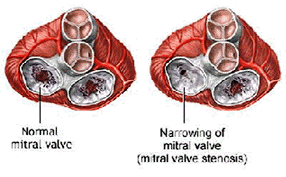[su_divider top=”no” style=”double” divider_color=”#952524″ link_color=”#952524″ size=”2″ margin=”10″]
Mitral Stenosis? What is the main cause? What are the signs and symptoms? How can homeopathy help you? All of this answered, in this post and of course our doctors always there to help you. Just fill in your details in the form down below and we will answer all your questions for FREE!
[su_divider top=”no” style=”double” divider_color=”#952524″ link_color=”#952524″ size=”2″ margin=”10″]
[sc name=”query”]

1)What is Mitral stenosis?
The mitral valve is a bicuspid valve which separates the upper chamber (left atrium) and the lower chamber (left ventricle) of a left side of the heart. Stenosis means narrowing, so in mitral stenosis there occurs narrowing of the mitral valve of the heart due to which mitral valve does not open fully and restricts the blood flow.
There are a number of conditions that can stimulate or trigger the physiology of mitral stenosis and these are as follows-
• Infective endocarditis with large vegetations.
• Left atrial myxoma.
• Ball valve thrombus.
• Nonrheumatic mitral annular calcification.
Mitral stenosis occurs a long time after the episode or attack of rheumatic fever. Stenosis of the mitral valve occurs decades after the episode of rheumatic carditis.
During an acute attack there occurs a number of inflammatory foci (Aschoff’s bodies) in the myocardium and endocardium. Such types of vegetations are also found on the border of the valve. With time the valve structure starts becoming thickened, calcified and contracted and also commissural adhesion occurs, these conditions ultimately lead to stenosis of the mitral valve.
2)What is the main cause of mitral stenosis?
• Rheumatic fever is the most common cause that leads to mitral stenosis.
• Other factors which can lead to the development of mitral stenosis are as follows
Calcium deposits or calcification of the mitral valve leaflets.
Radiation treatment to the chest is also one of the leading causes of damaging the function of the mitral valve.
Congenital heart disease can also lead to dysfunctioning of the mitral valve.
Some medications can lead to damage to the mitral valve.
• Other causes include infective endocarditis.
• Congenital heart diseases can also lead to the development of mitral stenosis in later part of life.
• Congenital defects of the mitral valve.
• Mitral stenosis runs in families.
What are the signs and symptoms?
In cases of adults, the symptoms are rare to be seen. Symptoms appear with exercise or due to doing any activity that results in increasing the heart rate.
The beginning of the symptoms occurs with an episode of atrial fibrillation.
Symptoms may include
• Discomfort in chest
Increases in activity decrease with rest.
Discomfort radiates to the arm, neck, jaw or other areas.
There is the feeling of tightness, crushing, pressure, squeezing and constriction in the chest.
• A cough may be bloody that is hemoptysis occurs.
• There is difficulty in breathing during and after the exercise, or when the patient is lying in a flat position, or the patient may wake up with difficulty breathing.
• The patient becomes easily tired.
• There may occur recurrent respiratory infections such as bronchitis.
• The patient feels palpitations.
• Swelling of feet and ankles is present along with other symptoms.
In children where mitral stenosis occur as a congenital disease present the following symptoms
• A cough.
• Shortness of breath.
• Poor growth.
• Poor feeding or sweating when feeding.
3)What does mitral valve stenosis sound like?
The intensity of first heart sound is increased while the second heart sound is normal. The low pitched rumbling murmur starts after the opening snap and remain until mid-diastole.
4)How do you diagnose mitral stenosis?
Transesophageal echocardiogram
Electrocardiogram (ECG)
Chest X-ray
Cardiac catheterization
5)How many years does a mitral valve repair last?
95% of patients are better after mitral valve repair for10 years, and this ratio is similar at 20 years. Thus, reoperation is rare after a successful surgeryof mitral valve repair. An echocardiogram is suggested yearly to assess valve function.
6)How homeopathy can help?
Apocynum vannabium
Cactus grandiflorus
Crategus oxyacantha
Laurocerasus
Strophanthus hispidus
For more information, you can visit MSD Manual and Wikipedia.
Mitral Stenosis
[sc name=”more-links-diseases”]

